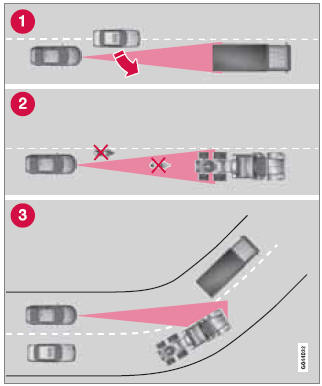Situations where ACC may not function optimally

![]() WARNING
WARNING
- The radar sensor has a limited field of vision. In some situations it may detect a vehicle later than expected or not detect other vehicles at all.
- If ACC is not functioning properly, cruise control will also be disabled.

Radar sensor's field of vision (shown in pink)
1 - In certain situations, the radar sensor cannot detect vehicles at close quarters, for example a vehicle that suddenly enters the lane between your vehicle and the target vehicle.
2 - Small vehicles, such as motorcycles, or vehicles not driving in the center of the lane may remain undetected.
3 - In curves, the radar sensor may detect the wrong vehicle or lose sight of the target vehicle.
![]() WARNING
WARNING
- Adaptive Cruise Control cannot cover all driving situations and traffic, weather and road conditions. The "Function" section provides information about limitations that the driver must be aware of before using this feature.
- This system is designed to be a supplementary driving aid. It is not, however, intended to replace the driver's attention and judgement. The driver is responsible for maintaining a safe distance and speed and must intervene if Adaptive Cruise Control does not maintain a suitable speed or suitable distance to the vehicle ahead.
- Maintenance of ACC components may only be performed by a trained and qualified Volvo technician.
![]() WARNING
WARNING
- Adaptive Cruise Control is not a collision avoidance system. The driver is always responsible for applying the brakes if the system does not detect another vehicle.
- Adaptive Cruise Control does not react to people or animals, or small vehicles such as bicycles and motorcycles. It also does not react to slow moving, parked or approaching vehicles, or stationary objects.
- Do not use Adaptive Cruise Control in demanding driving conditions such as city driving or other heavy traffic situations, in slippery conditions, when there is a great deal of water or slush on the road, during heavy rain or snow, in poor visibility, on winding roads or on highway on- or off-ramps.
See also:
Occupant safety reminders
How safely you drive doesn't depend on how
old you are but rather on:
Х How well you see.
Х Your ability to concentrate.
Х How quickly you make decisions under
stress to avoid an accident.
T ...
Volume control
Turn the knob (2) clockwise or counterclockwise
to raise or lower the volume. The volume
control is electronic and has no end position.
Volume can also be raised (+) or lowered (Ц)
using the ste ...
Design concept
At the front, the traditional Volvo V-shaped bonnet incorporates a grille
with a wide chrome surround and three-dimensional mesh inserts, plus a large
Volvo 'iron mark' badge. The front bumper has ...
